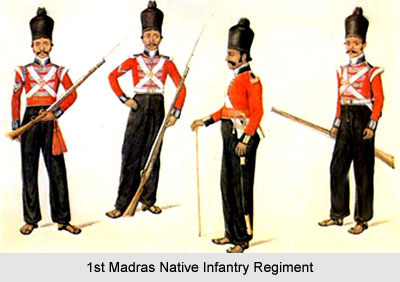 The 1st Madras Native Infantry was an infantry battalion of the British East India Company, which existed from the year 1758 to 1922. It was a part of the Madras Native Infantry under the Army of the Madras province, before the commencement of the Great Revolt of 1857. The Madras Army was the armed forces of Madras Presidency and one of the 3 major Presidency Armies in British India. The Army of Madras Presidency was established with the purpose of protecting the commercial interests of the British East India Company. The British Presidency Armies belonged to the British East India Company until the Sepoy Mutiny of 1857. Later in the year 1903, the 3 separate presidency armies were merged to form the United British Indian Army. The army unit was also incorporated as a part of the Madras Command. The 1st Madras Native Infantry was also known as the 61st Pioneers regiment.
The 1st Madras Native Infantry was an infantry battalion of the British East India Company, which existed from the year 1758 to 1922. It was a part of the Madras Native Infantry under the Army of the Madras province, before the commencement of the Great Revolt of 1857. The Madras Army was the armed forces of Madras Presidency and one of the 3 major Presidency Armies in British India. The Army of Madras Presidency was established with the purpose of protecting the commercial interests of the British East India Company. The British Presidency Armies belonged to the British East India Company until the Sepoy Mutiny of 1857. Later in the year 1903, the 3 separate presidency armies were merged to form the United British Indian Army. The army unit was also incorporated as a part of the Madras Command. The 1st Madras Native Infantry was also known as the 61st Pioneers regiment.
History of 1st Madras Native Infantry
The 1st Madras Native Infantry was raised as the 1st Battalion Coast Sepoys in the year 1758 by the Honourable British India Company. The military battalion fought in the Carnatic Wars from 1746 to 1763 and later took part in the Third Mysore War. The unit also participated in the Fourth Anglo Mysore War and fought in the Battle of Ava, the Battle of Nagpore (Nagpur), the Battle of Seringapatam and the Battle of Seedaseer. During the Great Revolt of 1857, 1st Madras Native Infantry did not rebel against the British East India Company and remained loyal to the British. The troops of the regiment fought in the Central India Campaign during this period. The army unit was later stationed abroad and participated in the Second Burmese War, the Boxer Rebellion and the Second Afghan War. The regiment was included as a part of the 9th (Secunderabad) Division in the 27th Bangalore Brigade during the First World War.
They later provided military service as part of the Indian Expeditionary Force B in British East Africa. The 1st Madras Native Infantry regiment also fought in the Third Anglo Afghan War, after the unit went back to British India. After the culmination of World War I, the British Government of India restrcutured and renumbered the British Indian army. The different single battalion infantry regiments were amalgamated together in order to form multi battalion regiments. In the year 1922, the regiment was re-designated as the 1st Battalion 1st Madras Pioneers. However the 61st Pioneers regiment was dissolved in 1933.
Designations of 1st Madras Native Infantry
The 1st Madras Native Infantry regiment of the British Indian Army held several designations through out its existence. These are listed as follows -
* 1st Battalion Coast Sepoys (1758)
* 1st Carnatic Battalion (1769)
* 1st Madras Battalion (1784)
* 1st Battalion, 1st Madras Native Infantry (1796)
* 1st Madras Native Infantry (1824)
* 1st Madras Native Infantry Pioneers (1883)
* 1st Madras Infantry Pioneers (1885)
* 1st Madras Pioneers (1901)
* 61st Madras Pioneers (1903)
* 61st Prince of Wales`s Own Pioneers (1906)
* 61st King George`s Own Pioneers (1910)



















